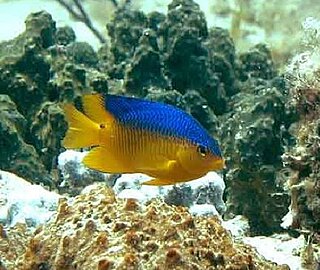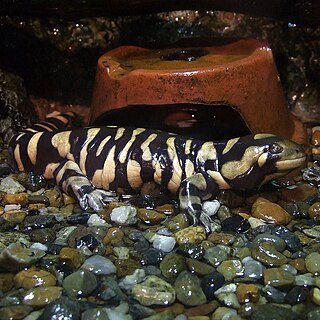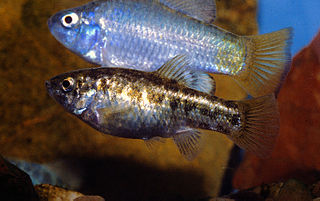
Amphiuma is a genus of aquatic salamanders from the United States, the only extant genus within the family Amphiumidae. They are colloquially known as amphiumas. They are also known to fishermen as "conger eels" or "Congo snakes", which are zoologically incorrect designations or misnomers, since amphiumas are actually salamanders, and not fish, nor reptiles and are not from Congo. Amphiuma exhibits one of the largest complements of DNA in the living world, around 25 times more than a human.

Damselfish are those within the subfamilies Abudefdufinae, Chrominae, Lepidozyginae, Pomacentrinae, and Stegastinae within the family Pomacentridae. Most species within this group are relatively small, with the largest species being about 30cm in length. Most damselfish species exist only in marine environments, but a few inhabit brackish or fresh water. These fish are found globally in tropical, subtropical, and temperate waters.

The greater siren is an eel-like amphibian and one of the three members of the genus Siren. The largest of the sirens and one of the largest amphibians in North America, the greater siren resides in the coastal plains of the southeastern United States.

The common collared lizard, also commonly called eastern collared lizard, Oklahoma collared lizard, yellow-headed collared lizard, and collared lizard, is a North American species of lizard in the family Crotaphytidae. The common name "collared lizard" comes from the lizard's distinct coloration, which includes bands of black around the neck and shoulders that look like a collar. Males can be very colorful, with blue green bodies, yellow stripes on the tail and back, and yellow orange throats. There are five recognized subspecies.

The barred tiger salamander or western tiger salamander is a species of mole salamander that lives in lower western Canada, the western United States and northern Mexico.
Mucophagy is defined as the act of feeding on mucus of fishes or invertebrates. Also, it may refer to consumption of mucus or dried mucus in primates.

Hybognathus is a genus of ray-finned fish in the family Cyprinidae. Its members are collectively known as the silvery minnows. Hybognathus are pelagophils that are native to North America. The populations of such pelagophils, including species of Hybognathus, continue to decrease in their natural habitats.
The Caddo madtom is a species of fish in the family Ictaluridae endemic to the United States. N. taylori was named in honor of William Ralph Taylor, U.S. National Museum, in recognition of his contributions to the knowledge of catfishes. They average 2 to 4 inches long and weigh no more than a few ounces. N. taylori has a small to tiny, fragmented range, but is mostly found in the Caddo, Ouachita, and Little Missouri Rivers in southwestern Arkansas. Ecological studies indicate that dam and bridge construction poses barriers to dispersal and migration of fish in the Ouachita Highlands. IUCNredlist.org states that better information is needed on life history, reproductive biology, and ecology of the Caddo madtom. This species is listed as endangered on the IUCN Red List. Limited range makes this species vulnerable to habitat destruction/degradation from impoundment, pollution, and other factors. Robison and Buchanan (1988) stated, "this rare species should be considered threatened due to loss of habitat". Warren et al. (2000) categorized the species as "threatened".

The loggerhead musk turtle is a species of turtle in the family Kinosternidae. This turtle has a large head which has a light-colored background with dark spots or stripes present on the head and neck. The average size of an adult loggerhead musk turtle is about 3–5 in (7.6–12.7 cm) in straight carapace length.

The desert pupfish is a rare species of bony fish in the family Cyprinodontidae. It is a small fish, typically less than 7.62 cm (3 in) in length. Males are generally larger than females, and have bright-blue coloration, while females and juveniles are silvery or tan. A notable attribute of the desert pupfish is their ability to survive in environments of extreme salinity, pH, and temperature, and low oxygen content. The desert pupfish mates in a characteristic fashion, wherein compatible males and females will come in contact and collectively jerk in an s-shape. Each jerk typically produces a single egg that is fertilized by the male and deposited in his territory. Breeding behavior includes aggressive arena-breeding and more docile consort-pair breeding.

The red shiner or red-horse minnow is a North American species of freshwater fish in the family Cyprinidae. They are deep-bodied and laterally compressed, and can grow to about three inches in length. For most of the year, both males and females have silver sides and whitish abdomens. Males in breeding coloration, though, have iridescent pink-purple-blue sides and a red crown and fins.

The brassy minnow is a species of fish belonging to the family Cyprinidae. The family Cyprinidae consists of mainly freshwater minnows and carps. The fish gets its scientific name from the Greek word Hybognathus, meaning bulging jaw, and hankinsoni from the American scientist, T.L. Hankinson. It is commonly found throughout the northern United States and Canada.

The creek chubsucker is a freshwater fish of the sucker family (Catostomidae).

Gorgasia is one of the two genera that belong to the subfamily Heterocongrinae. This genus is classified by the behavioral pattern of burrowing 75% of their bodies in the sandy substrate they live in and protruding their upper body into the water current above, giving the appearance that they are planted into the ground. This protruding behavior serves a multipurpose functionality to their survival.

The flame chub is a species of freshwater fish in the family Cyprinidae found only in the United States. Its range broadly follows the Tennessee River from above Knoxville, Tennessee, to the mouth of the Duck River. Historically the species was found in Kentucky, Tennessee, Alabama and Georgia. The preferred habitat of flame chub is in small flowing streams often associated with springs.
Derilissus is a genus of clingfishes belonging to the family Gobiesocinae found in the western Atlantic Ocean. This family of fish is identified by their appearance as small fish with sucking discs which allow them to attach themselves to various surfaces. Derilissus differs from other genera due to its attached gill membranes.

Nothonotus is a genus or subgenus of freshwater ray-finned fish, a darter from the subfamily Etheostomatinae, part of the family Percidae, which also contains the perches, ruffes and pikeperches. It is endemic to the southeastern United States. First proposed as a sub-genus of Etheostoma in 1988, there is still debate regarding the appropriate taxonomic rank of Nothonotus in the literature. Darter species comprise more than 180 of the Percidae taxa.
Gynogenesis, a form of parthenogenesis, is a system of asexual reproduction that requires the presence of sperm without the actual contribution of its DNA for completion. The paternal DNA dissolves or is destroyed before it can fuse with the egg. The egg cell of the organism is able to develop, unfertilized, into an adult using only maternal genetic material. Gynogenesis is often termed "sperm parasitism" in reference to the somewhat pointless role of male gametes. Gynogenetic species, "gynogens" for short, are unisexual, meaning they must mate with males from a closely related bisexual species that normally reproduces sexually.

Allotoca goslinei, commonly known as the banded allotoca or tiro rayado in Spanish, is a species of fish in the family Goodeidae. First described in 1987, it was once endemic only to the Ameca River basin in the Mexican state of Jalisco. It is now known to be extinct in the wild.
Erik Bertelsen was a Danish ichthyologist, who specialised in deep sea fish. The fish, Diaphus bertelseniNafpaktitis, 1966 is named in his honour.















